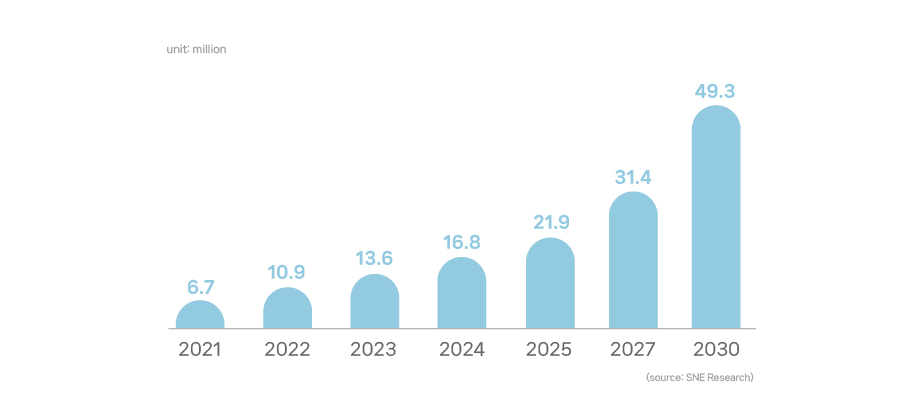Technology & Products
[Battery101] The Heart of Electric Vehicles: Battery
2024.05.10
|
101[wʌ́nouwʌ́n] means basic knowledge of a topic or collection of introductory materials to a topic. Our Battery 101 series talks about all things battery: the history, technical aspects (basic principles and mechanisms), industrial aspects (IT, electric vehicles, ESS, etc.), and next-generation technologies that SAMSUNG SDI will innovate while opening up its future. Batteries have infinite potentials that exceeds our wildest imagination. Through Batteries 101 series, you will have a chance to see the entire spectrum of the battery's possibilities and to conjure SAMSUNG SDI’s pivotal role in it. |
The EV market grows rapidly
The global sales of electric vehicles have grown rapidly over the past few years. Market research firm SNE Research expects global sales of electric vehicles to grow rapidly, surpassing 10 million units in 2022, reaching 21.9 million units in 2025 and 50 million units in 2030. This report added that the world-wide movement to achieve carbon neutrality would accentuate aspects of electric vehicles such as almost-zero emissions and high fuel efficiency.

[The outlook for the global EV market]
Increasing EV sales means that the demand for the batteries, the heart of those electric cars, is rising as well as the demand for the entire industry chain linked with the EVs, such as EV charging stations. Now you see why everyone's attention is focused on countless new opportunities generated by the electric vehicle business.
Electric car industry grew with eco-friendly car promotion policy
It was in the 1980s when realistic discussions on eco-friendly cars began. The United States was looking for a solution as the smog had been a serious issue. Accordingly, the car industry stepped up and began conversations on environmentally-friendly cars.
In 1990, the state government of California was very active in making an eco-friendly policy and adopted Zero-Emission Vehicle (ZEV) mandate that limits gas emissions from internal combustion engine (ICE) cars. This regulation required that 2 to 5 percent of the vehicles produced for sale by large automakers should be ZEVs starting from 1998 through 2002.
At the time, the automakers were lack of ZEV related technologies, and the cost of manufacturing was not so cheap, either. In 1998, the California government adjusted the mandate to allow partial ZEV credits and PZEV (partial ZEVs) credits for battery dominant hybrid-plugin electric vehicles.
Today, with growing global concerns about climate change, pro-EV policies are actively underway not only in the United States but also throughout the world, including Europe and Asia. Currently, there are two major policy tracks when it comes to electric vehicles: a move to expand the EV deployment, which can be categorized as the California government's regulatory policy mentioned earlier as an attempt to boost electrification for the sake of environment protection. Additional examples include "Fit for 55," EU's target to reduce carbon emissions by 55% in 2030 from the 2021 level, and Chinese government's bill to ban the sale of internal combustion engine vehicles in 2035.
On the other hand, there are regulatory policies aimed to foster the domestic battery industry. As the global EV market becomes larger and larger, each country's race to rise as a dominating power in the market is also intensifying. The Inflation Reduction Act (IRA) in the United States is the one.

[The global EV sales]
Driven by the global policy efforts, the International Energy Agency (IEA) released the Global EV Outlook 2024 in April 2024. It reported that the global EV sales recorded 16.6 million units in 2023, a five-fold rise from 3 million in 2020, demonstrating a rapid growth of the market.
Battery as the heart of electric vehicles
The battery industry is said to be standing in the front and center of the great power competition between the US and China. Like so, many countries are scrambling to get ahead in the battery business as seen in the formation of a number of battery alliances and the creation of businesses within the battery value chain. The Korean government has designated the battery technology as one of the ten core, strategic technologies. The range of an electrified car barely reached 100 km back in 2012. In 2018, it surpassed 400 km, and an EV with the average range of 800 km has been introduced recently. Advances in battery performance are directly linked to advances in electric vehicles, as the battery determines the key performance of an electric vehicle, such as range and charging speed. The future of batteries is bright as they drive the development of electric vehicles.
